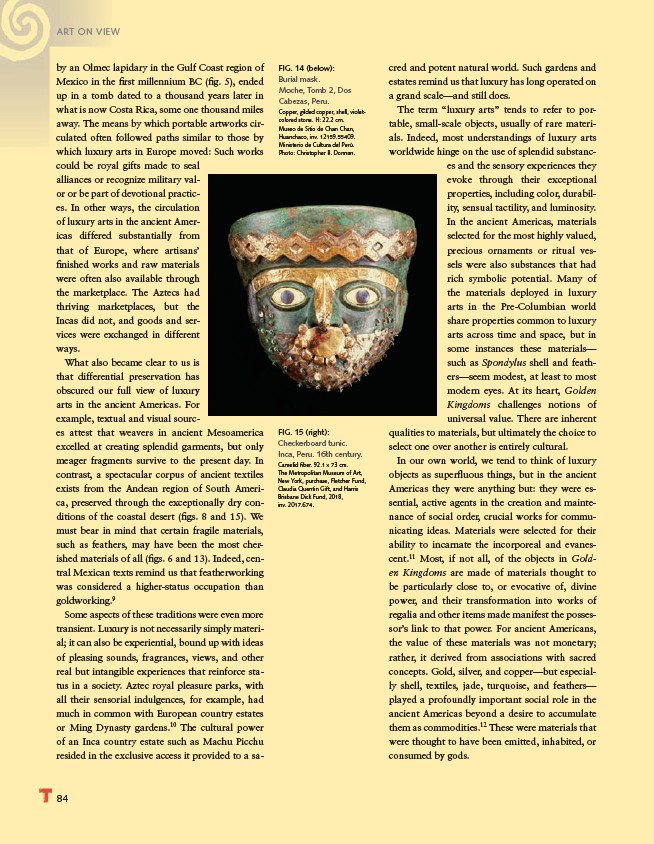
84
FIG. 14 (below):
Burial mask.
Moche, Tomb 2, Dos
Cabezas, Peru.
Copper, gilded copper, shell, violetcolored
stone. H: 22.2 cm.
Museo de Sitio de Chan Chan,
Huanchaco, inv. 12159.55409.
Ministerio de Cultura del Perú.
Photo: Christopher B. Donnan.
FIG. 15 (right):
Checkerboard tunic.
Inca, Peru. 16th century.
Camelid fi ber. 92.1 x 73 cm.
The Metropolitan Museum of Art,
New York, purchase, Fletcher Fund,
Claudia Quentin Gift, and Harris
Brisbane Dick Fund, 2018,
inv. 2017.674.
ART ON VIEW
by an Olmec lapidary in the Gulf Coast region of
Mexico in the fi rst millennium BC (fi g. 5), ended
up in a tomb dated to a thousand years later in
what is now Costa Rica, some one thousand miles
away. The means by which portable artworks circulated
often followed paths similar to those by
which luxury arts in Europe moved: Such works
could be royal gifts made to seal
alliances or recognize military valor
or be part of devotional practices.
In other ways, the circulation
of luxury arts in the ancient Americas
differed substantially from
that of Europe, where artisans’
fi nished works and raw materials
were often also available through
the marketplace. The Aztecs had
thriving marketplaces, but the
Incas did not, and goods and services
were exchanged in different
ways.
What also became clear to us is
that differential preservation has
obscured our full view of luxury
arts in the ancient Americas. For
example, textual and visual sources
attest that weavers in ancient Mesoamerica
excelled at creating splendid garments, but only
meager fragments survive to the present day. In
contrast, a spectacular corpus of ancient textiles
exists from the Andean region of South America,
preserved through the exceptionally dry conditions
of the coastal desert (fi gs. 8 and 15). We
must bear in mind that certain fragile materials,
such as feathers, may have been the most cherished
materials of all (fi gs. 6 and 13). Indeed, central
Mexican texts remind us that featherworking
was considered a higher-status occupation than
goldworking.9
Some aspects of these traditions were even more
transient. Luxury is not necessarily simply material;
it can also be experiential, bound up with ideas
of pleasing sounds, fragrances, views, and other
real but intangible experiences that reinforce status
in a society. Aztec royal pleasure parks, with
all their sensorial indulgences, for example, had
much in common with European country estates
or Ming Dynasty gardens.10 The cultural power
of an Inca country estate such as Machu Picchu
resided in the exclusive access it provided to a sacred
and potent natural world. Such gardens and
estates remind us that luxury has long operated on
a grand scale—and still does.
The term “luxury arts” tends to refer to portable,
small-scale objects, usually of rare materials.
Indeed, most understandings of luxury arts
worldwide hinge on the use of splendid substances
and the sensory experiences they
evoke through their exceptional
properties, including color, durability,
sensual tactility, and luminosity.
In the ancient Americas, materials
selected for the most highly valued,
precious ornaments or ritual vessels
were also substances that had
rich symbolic potential. Many of
the materials deployed in luxury
arts in the Pre-Columbian world
share properties common to luxury
arts across time and space, but in
some instances these materials—
such as Spondylus shell and feathers—
seem modest, at least to most
modern eyes. At its heart, Golden
Kingdoms challenges notions of
universal value. There are inherent
qualities to materials, but ultimately the choice to
select one over another is entirely cultural.
In our own world, we tend to think of luxury
objects as superfl uous things, but in the ancient
Americas they were anything but: they were essential,
active agents in the creation and maintenance
of social order, crucial works for communicating
ideas. Materials were selected for their
ability to incarnate the incorporeal and evanescent.
11 Most, if not all, of the objects in Golden
Kingdoms are made of materials thought to
be particularly close to, or evocative of, divine
power, and their transformation into works of
regalia and other items made manifest the possessor’s
link to that power. For ancient Americans,
the value of these materials was not monetary;
rather, it derived from associations with sacred
concepts. Gold, silver, and copper—but especially
shell, textiles, jade, turquoise, and feathers—
played a profoundly important social role in the
ancient Americas beyond a desire to accumulate
them as commodities.12 These were materials that
were thought to have been emitted, inhabited, or
consumed by gods.